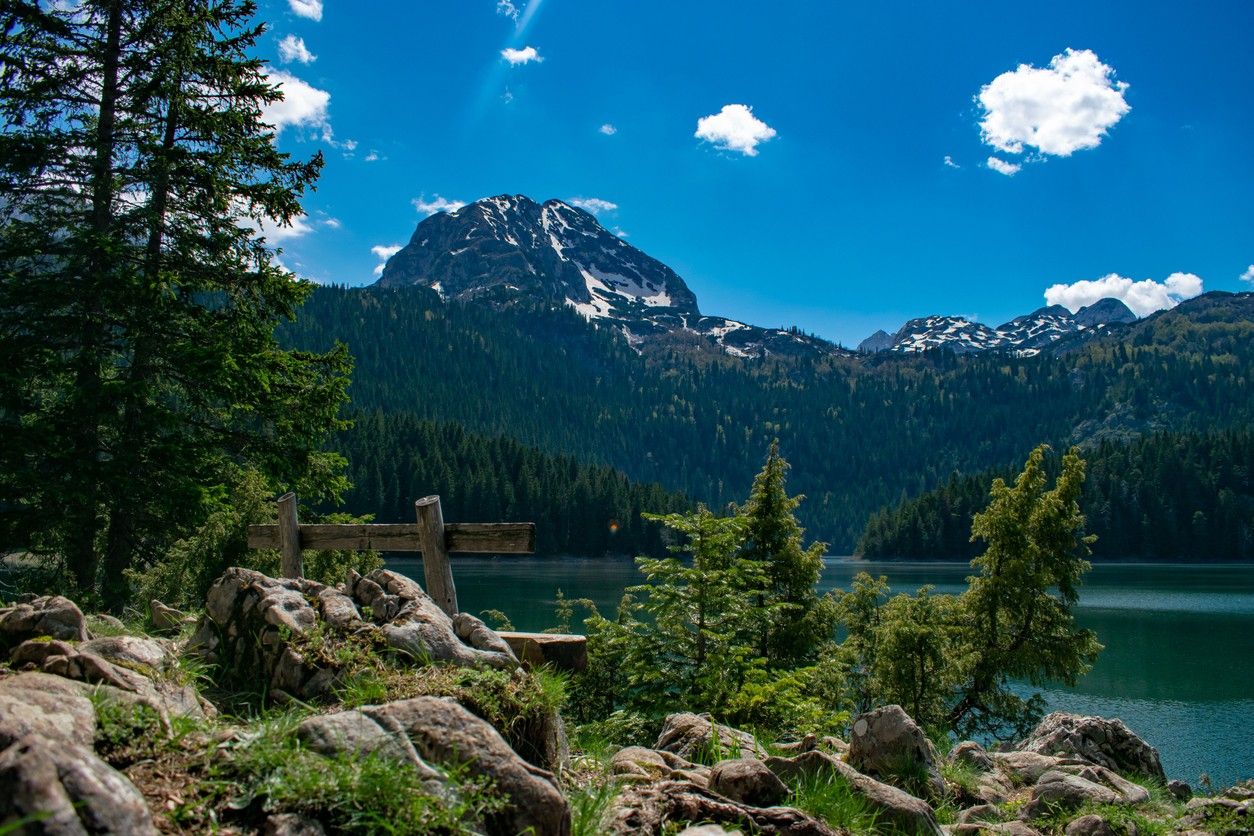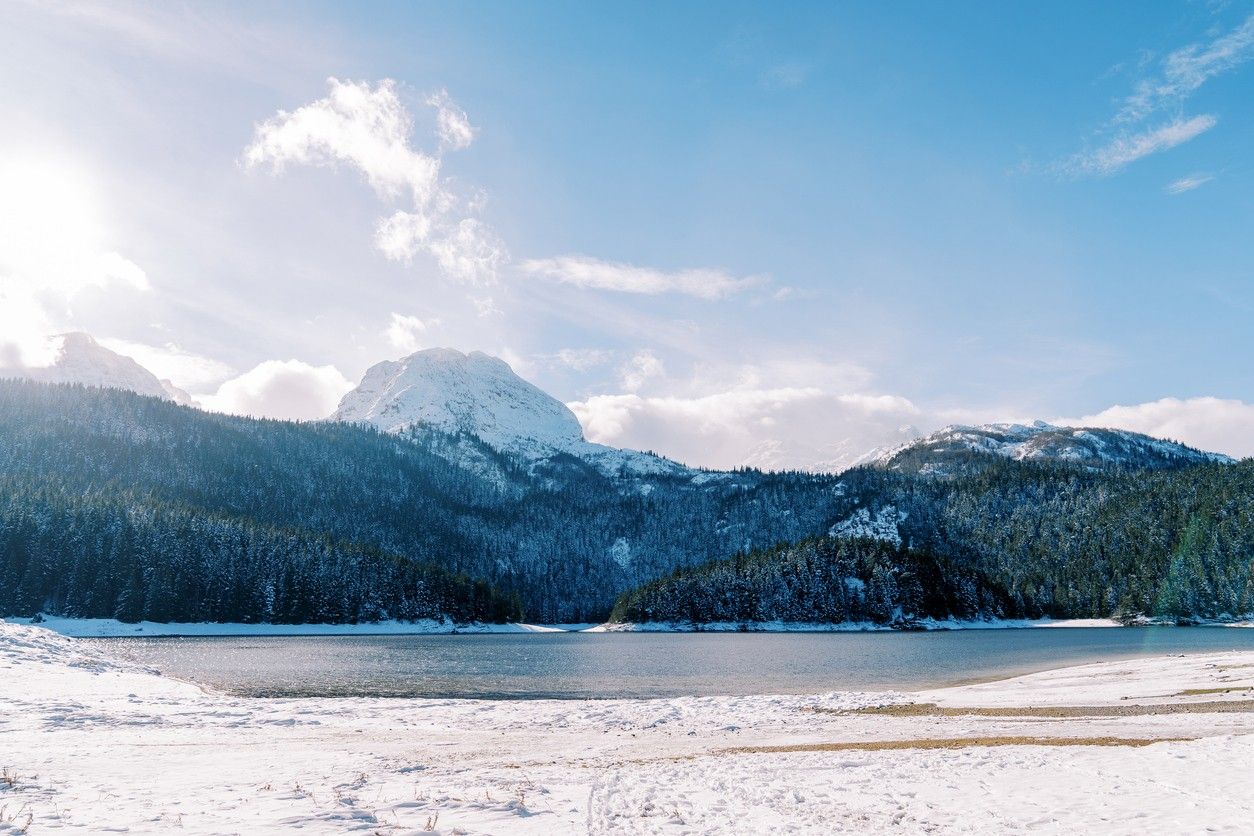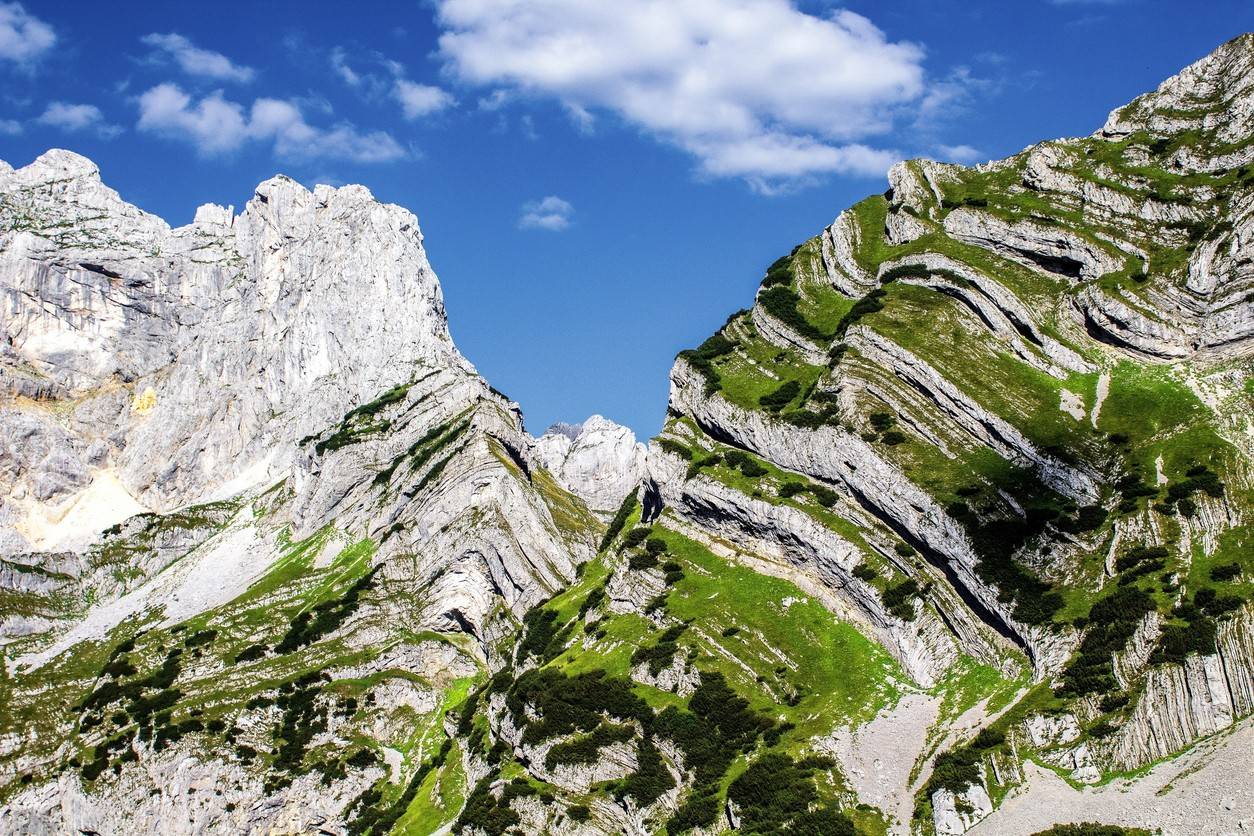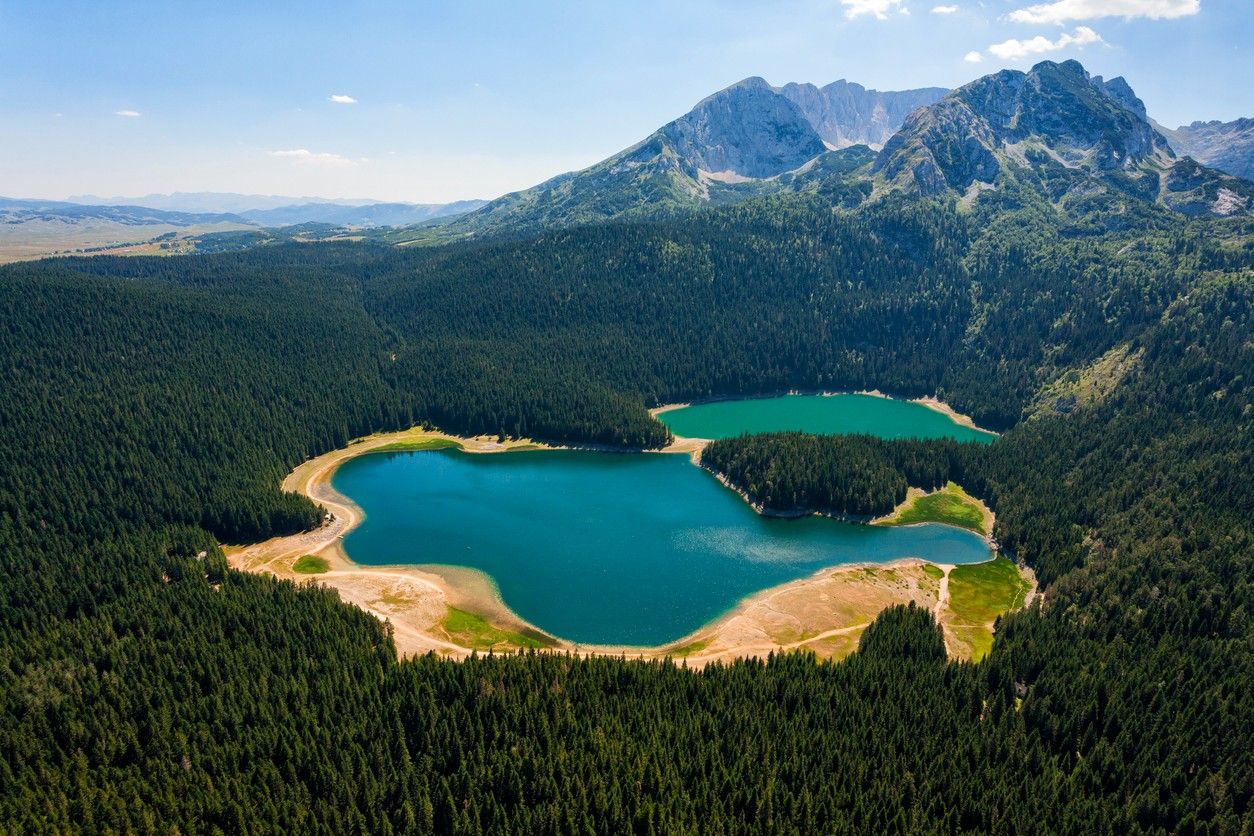Deep within the rugged heart of the Dinaric Alps, in the tiny nation of Montenegro, lies a wilderness paradise unlike any other – Durmitor National Park. This breathtaking expanse of jagged peaks, pristine glacial lakes, and ancient pine forests has earned its place among the world's most cherished natural wonders, designated as a UNESCO World Heritage Site for its outstanding universal value. Spanning a vast 39,000 hectares, Durmitor National Park is a realm where nature reigns supreme, offering a sanctuary for adventurers, nature enthusiasts, and those seeking to reconnect with the raw beauty of the great outdoors. From the towering summit of Bobotov Kuk, the highest peak in the Dinaric Alps, to the hauntingly beautiful Black Lake that mirrors the surrounding peaks in its inky depths, this extraordinary landscape is a tapestry of natural wonders woven together by the relentless forces of glaciation and erosion.
Conquering the Majestic Peaks
Durmitor National Park's crowning glory lies in its formidable mountain range, where the highest summit, Bobotov Kuk, soars to an impressive 2,522 metres. For avid hikers and mountaineers, these peaks present an irresistible challenge, promising breathtaking vistas and a true sense of accomplishment upon reaching their summits.
The Iconic Sedlo Ridge Trail
Among the park's many hiking trails, the Sedlo Ridge Trail stands out as an iconic and demanding trek that traverses the craggy ridge line, offering unparalleled panoramic views of the surrounding peaks and valleys. This challenging yet rewarding route demands a high level of skill, endurance, and preparation, as hikers navigate narrow ridges, steep ascents, and exposed sections with sheer drops on either side. The trail begins in the village of Zabljak, winding its way through dense pine forests and alpine meadows before reaching the base of the imposing Sedlo Ridge. From here, the real challenge begins, as hikers must navigate a series of steep switchbacks and rocky scrambles to gain the ridge line. The trail narrows considerably, with sheer cliffs dropping away on either side, requiring a steady foot and a head for heights. Once on the ridge, the trail undulates along the exposed spine, offering breathtaking vistas in every direction. To the east, the jagged peaks of the Durmitor Massif rise majestically, their rugged silhouettes etched against the sky. To the west, the verdant valleys and rolling hills of the Sinjajevina Mountain range stretch out as far as the eye can see. Throughout the hike, the panoramic views are simply breathtaking, with each turn revealing a new and awe-inspiring perspective.
The trail's difficulty should not be underestimated, however. Even experienced hikers will find themselves challenged by the steep inclines, loose scree sections, and exposure to the elements. Proper hiking gear, including sturdy boots, trekking poles, and plenty of water and snacks, is essential. Additionally, the weather in the mountains can change rapidly, with sudden storms or dense fog posing a serious risk to hikers. Despite the challenges, the rewards of conquering the Sedlo Ridge Trail are immense. The sense of accomplishment that comes from completing this iconic hike is unparalleled, and the memories of the stunning vistas and rugged beauty of the landscape will linger long after the hike is over. Experienced guides can provide invaluable support and expertise, ensuring a safe and unforgettable journey along this iconic trail.
Summiting Bobotov Kuk
For those seeking the ultimate mountaineering challenge, the ascent to the park's highest peak, Bobotov Kuk, is an adventure like no other. This strenuous trek takes hikers through a diverse range of terrain, from dense forests and alpine meadows to rocky scrambles and exposed ridgelines. The final push to the summit is a true test of endurance, as climbers navigate steep, rocky sections and navigate the occasional snow field. The journey to Bobotov Kuk typically begins in the village of Zabljak, where hikers embark on a multi-day trek through the heart of the Durmitor Massif. The first few days are spent traversing lush meadows and dense pine forests, gradually gaining elevation as the towering peaks come into view. Along the way, hikers may catch glimpses of the park's diverse wildlife, including the elusive Balkan chamois and soaring golden eagles.
As the trail ascends, the terrain becomes increasingly rugged, with steep, rocky sections and exposed ridgelines that demand careful footwork and a head for heights. Experienced mountaineering guides are essential for navigating these treacherous stretches, ensuring the safety of the group and providing invaluable expertise on the ever-changing conditions. The final push to the summit is a true test of physical and mental fortitude, as climbers must scramble over loose scree and navigate narrow ledges with sheer drops on either side. The thin mountain air and challenging terrain can take a toll, but the reward that awaits at the top makes every step worth the effort.
From the 2,522-metre summit of Bobotov Kuk, the entire expanse of Durmitor National Park unfolds before your eyes, revealing a breathtaking panorama of jagged peaks, glacial lakes, and vast, untamed wilderness. The sense of accomplishment is overwhelming, as hikers stand atop one of the highest points in the Dinaric Alps, having conquered a true mountaineering challenge. Summiting Bobotov Kuk is an experience that will etch itself into memory forever. The physical and mental demands of the journey, combined with the awe-inspiring beauty of the surrounding landscape, create a profound connection with the raw power and majesty of nature that few experiences can match.
Exploring the Glacial Wonders
One of Durmitor National Park's most captivating features is its collection of glacial lakes, formed by the melting of ancient glaciers that once blanketed the region.
Kayaking and Paddling on the Glacial Lakes
For those seeking a more immersive experience with Durmitor's glacial wonders, the park offers opportunities for kayaking, canoeing, and stand-up paddleboarding on select lakes during the warmer months. Gliding across the glassy surface of these pristine waters, surrounded by towering peaks and dense pine forests, is an experience that truly connects visitors with the raw beauty of nature.
Black Lake (Crno Jezero) — The largest glacial lake, covering 0.5 square km, is located in the northern part of the park near Zabljak village.
Zminje Jezero — Situated just 2 km southwest of Black Lake in a picturesque valley surrounded by peaks.
Valovito Jezero — Found in the heart of Durmitor Massif, about 8 km southeast of Zabljak village.
Barno Jezero — Remote lake accessed by a 12 km hiking trail from the Zadnja Vrata area in the southwestern part of the park.
Vrazje Jezero — Tiny Lake located high up at 1,675 m elevation, 5 km northwest of Zabljak near Savin Kuk peak.
Zminicko Jezero — Tranquil lake nestled amid pine forests, around 3 km southwest of the popular Sedlo viewpoint.
Malo Skrcko Jezero — One of the scenic Skrcka Lakes, situated around 6 km southeast of Zabljak village.
Veliko Skrcko Jezero — Largest of the Skrcka Lakes group, located 7 km southeast of Zabljak at 1,667 m elevation.
Riblje Jezero — Accessible via a 9 km hiking trail from Valovito Lake, this remote lake is a paradise for anglers.
Local outfitters offer guided tours and equipment rentals, ensuring a safe and memorable experience on these glacial lakes. Experienced guides not only provide the necessary gear and instruction but also share their knowledge of the park's natural history, pointing out unique geological features, and sharing stories of the region's rich cultural heritage. For those who prefer to explore at their own pace, self-guided kayaks or canoe rentals are available, allowing visitors to chart their course across the serene waters. However, it is crucial to adhere to the park's regulations, respect wildlife, and exercise caution, as the lakes can be subject to sudden weather changes and strong winds.
Angling in Durmitor's Waters
Anglers, too, will find solace in the park's lakes and streams, which are home to a variety of trout species, including the elusive Durmitor trout. With the proper permits and respect for the park's regulations, fishing in these pristine waters can be a serene and rewarding pursuit, allowing visitors to disconnect from the hustle of daily life and immerse themselves in the tranquillity of the great outdoors. The clear, cold waters of the park's rivers and streams provide ideal conditions for fly fishing, as anglers cast their lines amidst the breathtaking natural scenery. The Tara River, a UNESCO-protected waterway that carves its way through the heart of the park, is a particular highlight for fly fishermen, offering opportunities to pursue brown trout, rainbow trout, and the elusive Durmitor trout, a species found nowhere else on Earth. Experienced guides can provide invaluable local knowledge, sharing insider tips on the best fishing spots, techniques, and times of day for the most productive angling. They can also offer instruction and guidance for those new to fly fishing, ensuring a safe and enjoyable experience on the water.
Beyond the thrill of the catch, fishing in Durmitor National Park offers a unique opportunity to connect with nature on a deeper level. As anglers wade into the crystal-clear streams, surrounded by towering peaks and pristine wilderness, they can't help but feel a sense of reverence and appreciation for the natural world around them. Sustainable fishing practices are of utmost importance in the park, with strict regulations in place to protect fish populations and preserve the delicate ecosystems. Catch-and-release policies are often enforced, and anglers are expected to adhere to designated fishing areas and seasons. Overnight camping trips along the park's rivers and streams can be arranged, allowing anglers to fully immerse themselves in the wilderness and chase their quarry from dawn till dusk. These multi-day excursions offer a chance to disconnect from the modern world and reconnect with the rhythms of nature, creating lasting memories and a deeper appreciation for the beauty of Durmitor National Park.
A Haven for Wildlife
Durmitor National Park is more than just a playground for outdoor enthusiasts; it is also a vital sanctuary for a diverse array of flora and fauna.
Spotting the Elusive Balkan Chamois
One of the park's most iconic inhabitants, and a true highlight for wildlife enthusiasts, is the Balkan chamois – a nimble and agile mountain goat-antelope that can be spotted navigating the park's cliffs and rocky outcrops with remarkable dexterity. These elusive creatures, with their distinctive curved horns and tawny coats, are a sight to behold as they effortlessly traverse terrain that would challenge even the most experienced mountaineers. Spotting the Balkan chamois in its natural habitat is a true test of patience and perseverance, as these shy animals are well-camouflaged and highly attuned to their surroundings. Often found in small herds, they can be seen grazing on the park's alpine meadows or scaling seemingly impassable rock faces with ease, their sure-footed movements defying gravity. Patient observers may be rewarded with glimpses of these agile animals as they bound across steep slopes or pause to sun themselves on rocky outcrops. Their distinctive silhouettes, with their curved horns and muscular bodies, are a sight to behold against the backdrop of the rugged peaks and valleys.
Guided wildlife tours, led by knowledgeable local experts, can greatly increase the chances of spotting these remarkable creatures in their natural habitat. Experienced guides not only know where to look but also understand the chamois' behaviour patterns and preferred habitats, increasing the likelihood of a successful sighting. However, even if a direct encounter with the Balkan chamois proves elusive, the thrill of searching for these rare and elusive animals amidst the grandeur of Durmitor National Park is an experience in itself. The very presence of these hardy creatures serves as a testament to the park's ecological significance and the importance of preserving these fragile mountain ecosystems for future generations.
Birdwatching in Durmitor's Diverse Habitats
For birdwatchers and nature enthusiasts, Durmitor National Park offers a veritable paradise, with over 150 species of birds calling the park home. From the majestic golden eagle soaring overhead to the melodious songs of the Eurasian nuthatch and black woodpecker echoing through the forests, the park's avian diversity is a true spectacle to behold. The varied habitats, ranging from dense coniferous forests to alpine meadows and glacial lakes, provide a rich tapestry of ecosystems that support a wide range of bird species. Each habitat offers unique opportunities for birdwatchers to observe and appreciate the park's feathered residents in their natural environments. In the lush, evergreen forests, sharp-eyed observers may catch glimpses of the elusive hazel grouse, a rotund and well-camouflaged species that blends seamlessly into the dappled light and underbrush. Overhead, the distinctive calls of the Eurasian nuthatch and the drum-like pecking of the black woodpecker can often be heard, signalling the presence of these industrious birds.
As the terrain rises into the alpine meadows and rocky outcrops, the avian inhabitants change, with species like the rock partridge and the Alpine chough taking centre stage. These hardy birds have adapted to the harsh, high-altitude conditions, thriving amidst the rugged peaks and windswept slopes. Meanwhile, the park's glacial lakes and waterways attract a diverse array of waterfowl, including various species of ducks, grebes, and the majestic great crested grebe. These aquatic birds can be seen gracefully gliding across the glassy surfaces or taking flight in stunning displays of aerial acrobatics. Dedicated birding tours, led by knowledgeable guides, can provide invaluable insights into the park's feathered residents, as well as the best locations and times for spotting rare and elusive species.
Discovering the Park's Cultural Heritage
While Durmitor National Park is renowned for its natural splendour, it also holds a rich cultural heritage that has been woven into the fabric of this rugged landscape over centuries.
Exploring the Historic Village of Zabljak
One of the park's most intriguing cultural attractions is the village of Zabljak, nestled in the heart of the Durmitor Massif. This picturesque settlement, with its traditional stone houses and narrow, winding streets, has been inhabited for centuries by hardy mountain dwellers who have learned to thrive in this unforgiving yet beautiful environment. One of the highlights of exploring Zabljak is the opportunity to witness traditional crafts in action. Local artisans can often be seen practising age-old techniques, such as woodcarving, weaving, and metalworking, creating beautiful and functional objects that reflect the rich cultural heritage of the region. Visitors can also immerse themselves in the local culture by attending one of the many annual festivals and celebrations that take place in Zabljak. From the vibrant folk dances and music performances to the traditional culinary delights, these events offer a glimpse into the vibrant folklore and traditions that have been woven into the fabric of this remarkable community. Guided walking tours, led by knowledgeable locals, provide visitors with a deeper understanding of Zabljak's history and daily life. These tours often include visits to historic sites, such as the village's centuries-old Orthodox church or the traditional water mills that once harnessed the power of the nearby streams. Despite the challenges of living in a harsh mountain environment, the community has not only survived but thrived, preserving its unique cultural identity and traditions while adapting to the changing times.
Discovering Ancient Traditions and Customs
Beyond Zabljak, the park is dotted with numerous other historic villages and settlements, each with its unique character and story to tell. Guided tours or self-guided explorations offer visitors the opportunity to step back in time and gain a deeper appreciation for the resilience and resourcefulness of the people who have called this rugged land home for generations. One of the most fascinating aspects of exploring these ancient communities is witnessing the traditional practices and customs that have been passed down through the centuries.
In the village of Virak, for example, visitors can observe the ancient art of cheese-making, as local families gather to transform fresh milk from their herds into a variety of delicious cheeses using time-honoured techniques. The aroma of ageing cheese wafts through the narrow streets, mingling with the scent of woodsmoke from the village's stone hearths. Nearby, in the hamlet of Mala Crna Gora, the traditional practice of beekeeping is still alive and well. Here, visitors can learn about the intricate process of tending to the hives and extracting golden honey, a skill that has been passed down through generations of families in this tiny mountain community. Throughout these villages, the ancient rhythms of life are still very much in tune with the natural world. The changing of the seasons dictates the ebb and flow of daily activities, from the planting and harvesting of crops to the migration of livestock to higher pastures in the summer months.
Many villages offer the opportunity to stay in traditional guesthouses, where visitors can not only witness but also participate in the daily routines and customs of their hosts. From helping to tend the vegetable gardens to learning the art of traditional bread-making, these experiences offer a rare and authentic glimpse into a way of life that has endured for centuries in the rugged heart of Durmitor National Park.
Planning Your Durmitor Adventure
With its diverse array of natural wonders and cultural offerings, planning a visit to Durmitor National Park requires careful consideration to ensure a truly memorable and enriching experience.
Choosing the Right Accommodation
Accommodation options within the park range from rustic mountain huts and campsites to more modern hotels and lodges in nearby towns like Zabljak. For those seeking a truly immersive experience, camping in designated areas within the park allows for unparalleled stargazing and a deeper connection with the natural surroundings. However, campers should be prepared for the challenges of the rugged terrain and unpredictable weather, ensuring they have the proper equipment and supplies for a safe and comfortable outdoor adventure.
Alternatively, the park's mountain huts, or "katuns," offer a unique blend of rustic charm and essential amenities, providing hikers and adventurers with a warm and welcoming respite after a day of exploring the great outdoors. These traditional stone shelters, often staffed by friendly local hosts, offer basic accommodations and hearty meals, allowing visitors to truly immerse themselves in the authentic mountain culture of the region. For those preferring more modern comforts, the town of Zabljak offers a range of hotels and lodges, catering to various budgets and preferences. From cosy family-run inns to luxurious resorts with spa facilities, Zabljak provides a convenient base for exploring the park while still enjoying the amenities of a bustling mountain town.
Guided Tours and Activities
Guided tours and activities, such as hiking excursions, rock climbing, and wildlife watching, are available through local outfitters and can provide a wealth of knowledge and expertise, ensuring a safe and enriching experience. Experienced guides not only lead visitors along the park's best trails and viewpoints but also offer invaluable insights into the region's natural history, cultural traditions, and conservation efforts. For those seeking a more adrenaline-fueled adventure, rock climbing excursions led by certified instructors can provide a thrilling and unforgettable experience, as climbers scale the park's towering rock faces and sheer cliffs. With proper safety equipment and expert guidance, even novice climbers can experience the exhilaration of conquering these vertical challenges while taking in the breathtaking vistas that surround them.
Embracing Sustainable Tourism
As the popularity of Durmitor National Park continues to grow, visitors and the local community must embrace sustainable tourism practices to ensure the preservation of this natural wonder for future generations.
Minimising Environmental Impact — One of the key principles of sustainable tourism in Durmitor National Park is minimising the environmental impact of visitors. This can be achieved through various measures, such as adhering to designated trails, practising proper waste disposal, and respecting wildlife and their habitats. The park's management has implemented strict regulations and guidelines to ensure the protection of these sensitive areas, including limits on visitor numbers in certain areas, restrictions on campfires and camping locations, and strict enforcement of wildlife disturbance laws. Visitors are also encouraged to adopt a "leave no trace" mindset, minimising their impact on the park's delicate ecosystems by packing out all trash, using environmentally friendly products, and avoiding damaging or removing any natural materials, such as plants or rocks. By taking these simple yet crucial steps, visitors can help preserve the park's pristine beauty for future generations to enjoy.
Supporting Local Communities and Traditions — Supporting local communities and their traditional practices is an essential component of sustainable tourism in Durmitor National Park. By patronising locally owned businesses, purchasing handcrafted goods, and participating in cultural experiences, visitors not only contribute to the local economy but also help preserve the rich heritage and traditions of the region. Many local families and communities rely on tourism as a vital source of income, and by choosing to stay in traditional guesthouses, hiring local guides, and supporting locally run shops and restaurants, visitors can directly impact the well-being of these communities. Additionally, participating in cultural events and workshops, such as traditional dance performances, cooking classes, or artisan demonstrations, not only provides an enriching experience but also helps to sustain and promote the region's unique cultural identity.
Related articles

Let us know you agree to cookies
We use marketing, analytical and functional cookies as well as similar technologies to give you the best experience. Third parties, including social media platforms, often place tracking cookies on our site to show you personalised adverts outside of our website.
We store your cookie preferences for two years and you can edit your preferences via ‘manage cookies’ or through the cookie policy at the bottom of every page. For more information, please see our cookie policy.















